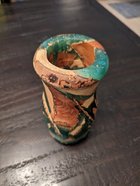I’ve been reading a lot about the use of epoxy for turning and one question (of many) that I have is how does pour depth apply to a turning blank placed in a container. I hope this question makes sense. Say you have placed a number of scraps in an 8” tall container (hopefully more illustrative than just saying “an odd shaped piece”), and you are using an epoxy that has a 2” pour depth spec.
Even though the container is 8” deep, the actual thickness of the epoxy at any one point would most likely be less than 2” because the wood is taking up most of the space.
Imagine pouring epoxy into an 8” x 8” x 1-1/2” mold. If the mold is sitting flat the the epoxy depth is 1-1/2”. If the mold is on its side then the epoxy depth is 8” but it’s still going to cure…..isn’t it? I’m thinking of the epoxy pour into the 8” container filled with blanks to be the same as turning the flat mold on its side, so you haven’t gone beyond the 2” pour limit. Does that make sense? How does “pour depth” apply to turning blanks?
I should mention that I tend to over think things.
Even though the container is 8” deep, the actual thickness of the epoxy at any one point would most likely be less than 2” because the wood is taking up most of the space.
Imagine pouring epoxy into an 8” x 8” x 1-1/2” mold. If the mold is sitting flat the the epoxy depth is 1-1/2”. If the mold is on its side then the epoxy depth is 8” but it’s still going to cure…..isn’t it? I’m thinking of the epoxy pour into the 8” container filled with blanks to be the same as turning the flat mold on its side, so you haven’t gone beyond the 2” pour limit. Does that make sense? How does “pour depth” apply to turning blanks?
I should mention that I tend to over think things.

